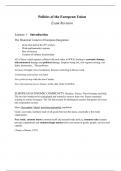Politics of the European Union
Exam Revision
Lecture 1 – Introduction
The Historical Context of European Integration
- In the first half of the 20th century:
- Weak parliamentary regimes
- Rise of fascism
- Creation of military dictatorships
All of these varied regimes collided with each other in WWII, leading to economic damage,
infrastructural damage and political damage. Empires being lost, new regimes arising, war
debts, destruction... The problems:
Germany brought a lot of confusion, because restricting it did not work.
Combatting nationalism was hard.
New political map with the Iron Curtain.
New international power balance at the start of the Cold War.
EUROPEAN ECONOMIC COMMUNITY: Benelux, France, West Germany and Italy.
The two last wanted to be reintegrated and wanted to recover from war. France remained
wanting to restrict Germany. The UK did not join for ideological reasons, but pushes for loose-
knit cooperation system.
Ideas: free market, liberal, non-interventionalist capitalism
Goals: ease trade, facilitate trade of all goods between the states, essentially a free trade
organization
Free trade, customs union (common tariff and external trade policy), common rules (cannot
prevent competition) and common/single market (free movement of goods, people, services and
capital).
(Treaty of Rome, 1957)
,ORGANIZATION FOR EUROPEAN ECONOMIC COOPERATION: divided the funds from
the Marshall plan, once becoming obsolete, turned into the Organization for Economic
Cooperation and Development. (1948)
COUNCIL OF EUROPE: promoting human rights (1949)
NATO: defensive alliance between Western European countries and the USA, to grant them
protection in case of invasions/threats and remain backed by the US (1949)
+ European Defense Community, 1950, rejected by France for fear of supranationalism, the goal
was to establish a European Army.
+ Western European Union, 1955, loosely structures defense organization, to allow Western
Germany into NATO as a permanent member
EUROPEAN COAL AND STEEL COMMUNITY (Treaty of Paris 1951)
- Schuman Declaration 1950: proposal to put French and German production of coal and
steel under a single authority --> ECSC (meant to be for 50 years)
Why? Schuman believed the materials were relevant in politics, driving materials for warfare.
Regulation = no country produce them for military purposes.
Implications? Above states, neutral, with independent officials. Composed of: the Special
Council, the Common Assembly and the Court of Justice.
,Messina Declaration, 1955:
+ Treaties of Rome, EEC + Euratom
Summary
- EEC more significant than ECSC for European Integration
- ECSC first organization of the EU
- EEC institutional structures still operation
- Many conflicts between supranational and intergovernmental institutions
- Political initiatives failed in cooperation with Western Europe, economic was the focus
Lecture 2 - History of European Integration
1960s – Present
We can study the history of European integration by looking at the chronology of events, the
treaties signed, the deepening of policies and institutions, in things like economic integration,
and the widening of membership. These all work together to provide a good understanding of the
history.
Chronological approach
- Focuses on grand steps, big events
- Things like crises, treaties, enlargements
, - Focuses on incremental steps
- Things like economic interdependence being achieved, political decisions regarding the
EU, such as the development of certain policy areas, and court judgements (in EU law
reigning supreme in the 60s)
Crises
By analyzing crises, we can understand how they affected the EU. The ‘empty chair’ example of
1965-6, when De Gaulle was unhappy with the EC as the budget was not advantageous to
France. He wanted Europe to have a common agricultural policy that protected farmers from the
free market. So, De Gaulle boycotted European institutions, leaving the Council of Ministers.
France was the chair of the Council. All the other states could not take decisions without France.
This led to the Luxembourg Compromise – allowing all member states do veto if a policy does
not align with their interests. From the 70s to the 80s, the European integration process was
halted, because of this veto power.
Treaties
Each treaty expanded EU policy areas, creating institutions and helping the integration process.
The treaties do not reflect the entire history – they are only adopted when the member states
agree.
From 80s to 00s, there were major rounds of treaty reforms. Some treaties were more important
than others
- Treaty establishing the European Coal and Steel Community (1951, entered into
force 1952). A founding treaty of the ECSC, it was signed for a 50-year duration, then
expired, and transferred to the EC.
- Treaty establishing the European Economic Community and the European Atomic
Energy Community (1957, entered into force in 1958)
o Treaty of Rome, Treaty on the Functioning of the EU (renamed in Lisbon)
- Single European Act (1986) ended the period of stagnation, introduced the Single Market





